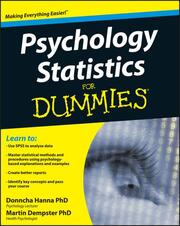Detailansicht
Psychology Statistics For Dummies
ISBN/EAN: 9781119952879
Umbreit-Nr.: 3505986
Sprache:
Englisch
Umfang: 462 S.
Format in cm: 2.6 x 23.6 x 19
Einband:
kartoniertes Buch
Erschienen am 07.12.2012
Auflage: 1/2012
- Zusatztext
- The introduction to statistics that psychology students can't afford to be without Understanding statistics is a requirement for obtaining and making the most of a degree in psychology, a fact of life that often takes first year psychology students by surprise. Filled with jargon-free explanations and real-life examples, Psychology Statistics For Dummies makes the often-confusing world of statistics a lot less baffling, and provides you with the step-by-step instructions necessary for carrying out data analysis. Psychology Statistics For Dummies: * Serves as an easily accessible supplement to doorstop-sized psychology textbooks * Provides psychology students with psychology-specific statistics instruction * Includes clear explanations and instruction on performing statistical analysis * Teaches students how to analyze their data with SPSS, the most widely used statistical packages among students
- Kurztext
- The quick, easy way to master all the statistics you'll ever need The bad news first: if you want a psychology degree you'll need to know statistics. Now for the good news: Psychology Statistics For Dummies. Featuring jargon-free explanations, step-by-step instructions and dozens of real-life examples, Psychology Statistics For Dummies makes the knotty world of statistics a lot less baffling. Rather than padding the text with concepts and procedures irrelevant to the task, the authors focus only on the statistics psychology students need to know. As an alternative to typical, lead-heavy statistics texts or supplements to assigned course reading, this is one book psychology students won't want to be without. * Ease into statistics - start out with an introduction to how statistics are used by psychologists, including the types of variables they use and how they measure them * Get your feet wet - quickly learn the basics of descriptive statistics, such as central tendency and measures of dispersion, along with common ways of graphically depicting information * Meet your new best friend - learn the ins and outs of SPSS, the most popular statistics software package among psychology students, including how to input, manipulate and analyse data * Analyse this - get up to speed on statistical analysis core concepts, such as probability and inference, hypothesis testing, distributions, Z-scores and effect sizes * Correlate that - get the lowdown on common procedures for defining relationships between variables, including linear regressions, associations between categorical data and more * Analyse by inference - master key methods in inferential statistics, including techniques for analysing independent groups designs and repeated-measures research designs Open the book and find: * Ways to describe statistical data * How to use SPSS statistical software * Probability theory and statistical inference * Descriptive statistics basics * How to test hypotheses * Correlations and other relationships between variables * Core concepts in statistical analysis for psychology * Analysing research designs Learn to: * Use SPSS to analyse data * Master statistical methods and procedures using psychology-based explanations and examples * Create better reports * Identify key concepts and pass your course
- Autorenportrait
- InhaltsangabeIntroduction 1 Part I: Describing Data 7 Chapter 1: Statistics? I Thought This Was Psychology! 9 Chapter 2: What Type of Data Are We Dealing With? 19 Chapter 3: Inputting Data, Labelling and Coding in SPSS 27 Chapter 4: Measures of Central Tendency 53 Chapter 5: Measures of Dispersion 73 Chapter 6: Generating Graphs and Charts 91 Part II: Statistical Significance 111 Chapter 7: Understanding Probability and Inference 113 Chapter 8: Testing Hypotheses 123 Chapter 9: What's Normal about the Normal Distribution? 139 Chapter 10: Standardised Scores 155 Chapter 11: Effect Sizes and Power 165 Part III: Relationships between Variables 183 Chapter 12: Correlations 185 Chapter 13: Linear Regression 211 Chapter 14: Associations Between Discrete Variables 243 Part IV: Analysing Independent Groups Research Designs 265 Chapter 15: Independent t-tests and Mann-Whitney Tests 267 Chapter 16: Between-Groups ANOVA 285 Chapter 17: Post Hoc Tests and Planned Comparisons for Independent Groups Designs 313 Part V: Analysing Repeated Measures Research Designs 327 Chapter 18: Paired t-tests and Wilcoxon Tests 329 Chapter 19: Within-Groups ANOVA 347 Chapter 20: Post Hoc Tests and Planned Comparisons for Repeated Measures Designs 379 Chapter 21: Mixed ANOVA 395 Part VI: The Part of Tens 415 Chapter 22: Ten Pieces of Good Advice For Inferential Testing 417 Chapter 23: Ten Tips for Writing Your Results Section 421 Index 425
